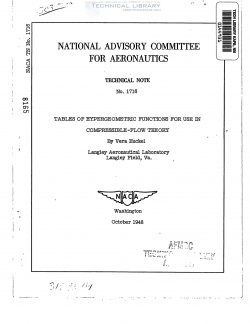naca-tn-1716
- Version
- 130 Downloads
- 992.53 KB File Size
- 1 File Count
- December 6, 2016 Create Date
- December 6, 2016 Last Updated
National Advisory Committee for Aeronautics, Technical Notes - Tables of Hypergeometric Functions for Use in Compressible Flow Theory

In the hodograph method of treating plane potential compressible
flows the differential equation, originally obtained by Chaplygin in
his study on gas Jets, plays a significant role. This paper tabulates
various hypergeometric functions which arise as particular solutions .of
Chaplygin's differential equation. The tables should prove useful in
the tabulation of other auxiliary functions which may arise in various
compressible-flow problems. The adiabatic index for air has been
taken as 1.1.
Any general theory of compressible potential flow will probably
involve the hodograph variables. A reason for this statement is that
in the hodograph plane, in which the independent variables are the
magnitude and the direction of the fluid velocity, the equations of
motion are linear; whereas, in the physical plane they are in general
an intractable set of nonlinear partial differential equations.
The simplification due to the use of hodograph variables, however,
presents certain difficulties which do not appear in the physical plane.
For example, application of the necessary boundary conditions for
uniform compressible flow past an arbitrary body is almost impossible,
at least up to the present time. Certain singularities in the flow also
appear, notably, near the sonic speed and in- the undisturbed flow at
infinity. Nevertheless, the possibility of getting around these and
other difficulties in the near future Justifies the publication of tables
for the fundamental set of functions which represent the particular
solutions of the flow equations in the' hodograph plane.
The following section contains equations and definitions necessary
for the understanding of the several functions listed in the tables.
The reader is referred to the original paper (reference 1) in which the
particular flow solutions are derived in detail.
| File | Action |
|---|---|
| naca-tn-1716 Tables of Hypergeometric Functions for Use in Compressible Flow Theory.pdf | Download |

Comment On This Post